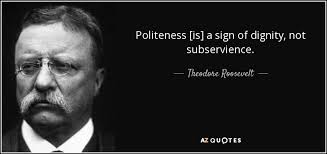The bounds of “normal” behavior are funny things. They are pervasive, and it is unimaginable to have a shared culture without them. Yet we all know that they shift over time. We can have passionate arguments over whether this or that shift is “progress” or “decline.” I tend to lean on the side of flexibility: maybe teaching helps this, since every year I get one year older, but I face a set of students in their seats who are ever-fixed in their 18-22-ness. Norms shift. Get too fixated on that shifting, and it can be bad.
But to say that norms shift shouldn’t mean anything goes. The existence of some sort of shared, relatively tacit expectations about behavior are extraordinarily valuable, and without them, much important work – from a classroom to a workplace to a government – cannot get done. And what we face right now is a kind of collapse of normalization, most visibly in the public sphere, but in fact infecting us all at more and more local levels all the time. Megan McArdle, whom I usually find a bit too pro-market for my taste, had an insightful column commenting on a recent speech by conservative Ben Shapiro at Berkeley. It went off without any violence… thanks to over $600,000 spent in extra security measures. McArdle wonders:
Shapiro arrived, gave his speech, and departed without the mayhem we’ve become accustomed to seeing at such appearances. And collective relief was sighed.But how relieved should we be that this is what it takes to maintain order in the face of … a speech? On the one hand it shows that even in the heart of antifa territory, police and authorities that are actually determined to control them can do so. That’s good to know (and gives the lie to chicken authorities who would give antifa a heckler’s veto). And yet, those authorities could be forgiven for feeling daunted, even aggrieved, when they realize that every speaker antifa doesn’t like means vast sums, and considerable effort, expended on turning your public spaces into a demilitarized zone.
I don’t have an ironclad date for when antifa became a recognizable, and destructive, force in our politics. But I really began to notice them around the time of Trump’s election, when I saw people defending their actions on the grounds that they were trying to stop Trump from being “normalized.” It was argued that protesting-as-usual — show up, mill around for a while, chant a bit, and then go home to see how much news coverage you got — was inadequate to our uniquely dangerous historical moment. Stronger action was called for.
I think it’s safe to say that Donald Trump has not been normalized by anyone. The media treats him with deep contempt — mostly earned, I’d argue, but still not the normal way you expect to see a president portrayed. Foreign leaders sure don’t seem to think he is normal, and nor do the bureaucracy or the courts. And partisans on both sides are behaving distinctly abnormally. They do not see themselves as arguing over policy or even values, but as engaged in an existential battle between good and evil, with President Trump as the avatar for one side or another.
But the process of not normalizing Trump has instead normalized a lot of other things, bad ones. Like public disorder. Like persistent, pervasive anxiety that often looks like mass hysteria. Like people on both sides who try to minimize the illiberal tactics of the radicals on their own side by pointing mostly to the offenses of the other. (Yes, President Trump, I’m looking at you. And also at the folks who held light-hearted debates about whether it was okay to sucker-punch Richard Spencer.)
It seems to me that this captures a problem in the present situation, a kind of mutually-assured cultural destruction cycle that, while constantly catalyzed by President Trump, ends up justifying all sorts of other ways of speaking and acting that are just as destructive. David Brooks comes to a similar analysis in a recent column, using “shredding” as an apt description of what we are collectively doing:
Trump is not good at much, but he is wickedly good at sticking his thumb in the eye of the educated elites. He doesn’t have to build a new culture, or even attract a majority. He just has to tear down the old one.
That’s exactly what he’s doing. Donald Trump came into a segmenting culture and he is further tearing apart every fissure. He has a nose for every wound in the body politic and day after day he sticks a red-hot poker in one wound or another and rips it open.
Day by day Trump is turning us into a nation of different planets. Each planet feels more righteous about itself and is more isolated from and offended by the other planets.
The members of the educated class saw this past weekend’s N.F.L. fracas as a fight over racism. They felt mobilized and unified in that fight and full of righteous energy. Members of the working class saw the fracas as a fight about American identity. They saw Pittsburgh Steelers coach Mike Tomlin try to dissuade Alejandro Villanueva, a three-time combat veteran, from celebrating the flag he risked his life for. Members of this class also felt mobilized, unified and full of righteous energy.
I don’t know which planet is bigger, or which would win an election, but that frankly doesn’t matter. All that matters is that Trump is shredding the culture and ending the dominance of the meritocratic establishment.
He continually goes after racial matters in part because he’s a bigot but also in part because multiculturalism is the theology of the educated class and it’s the leverage point he can most effectively use to isolate the educated class from everyone else.
He is so destructive because his enemies help him. He ramps up the aggression. His enemies ramp it up more, to preserve their own dignity. But the ensuing cultural violence only serves Trump’s long-term destructive purpose.
Note: the non-normal behavior used to resist Trump actually empowers him. This seems right.
However, both these columnists lean right, and so it would be important to recognize that the shredding is happening across the landscape. The non-normal behavior tolerated by those on the right is similarly emboldening the other side. Just this Wednesday morning, we in DC had headlines of confederate flags and cotton stalks being posted on the campus of American University by what turned out to be 40-something white male in construction gear. And this the morning after Alabama elected… the “Bannon candidate” over the “Trump candidate”! The non-normal behavior used to elect Trump actually will lead to his movement failing in the long run.
This cannot continue; this is the mutually assured (cultural) destruction. Every report of a “shredding” on one side can serve as a justification for some “shredding” on the other. The more we report on and pay attention to the non-normalized behavior on the “other” side, the more we then feel justified in overlooking non-normalized behavior on “our” side. And of course the needed correction really ought to come from people in our own camp.
I think perhaps we could raise three questions for moral reflection about this process. There may be more. These aren’t about the real and serious differences in moralities between the poles. It is more about whether and how we engage these differences, if we have to solve them together.
- It can’t be good versus evil. Yes, absolutely, I agree that one needs to be outspoken about injustice and wrong. But if we conceive of “the other” in a pure enemy form, we thereby suggest any and all treatment is fair game. Indeed, this is a cultural “war” properly so called. It is no longer a debate.
- Leaders on both sides who want civil, “normalized” discourse need to get entrepreneurial about modeling it publicly. The most natural place for this to happen would be among members of Congress, Each has interests that, unfortunately, often make such a stance electorally costly. Sadly, coverage often drives attention to those who say outlandish and uncooperative things. (Established media could do everyone a favor by ceasing to treat Trump’s tweets as mini-press-conferences.) Some people need to invest in the high road in a genuinely bipartisan way, to display both agreements and disagreements in a better form than we usually see.
- Academics need to shun internet performances in favor of arguments. George Packer wrote an extremely thoughtful, complex critique of Ta-Nehisi Coates’ essay, “The First White President.” In response to Packer, a law professor from Duke University wrote a column at HuffPo entitled “Whitesplaining Ta-Nehisi Coates,” which consisted of a drippingly-sarcastic, hyper-hyper-linked response, whose tone and content suggested not even a hint of respect for these serious respondants to Coates’s essay. This was not a serious response to Packer’s point; it was some sort of performance of rhetorical cleverness aimed at humiliating his opponents. Basically, none of us should do that. The fact that academics now engage in these performances is embarrassing.
There are surely other proactive responses. But since we are dealing with a broad sense of social norms – not with legislation – we surely need to be proactive in multiple ways, lest the shredders, on whichever side, win.




